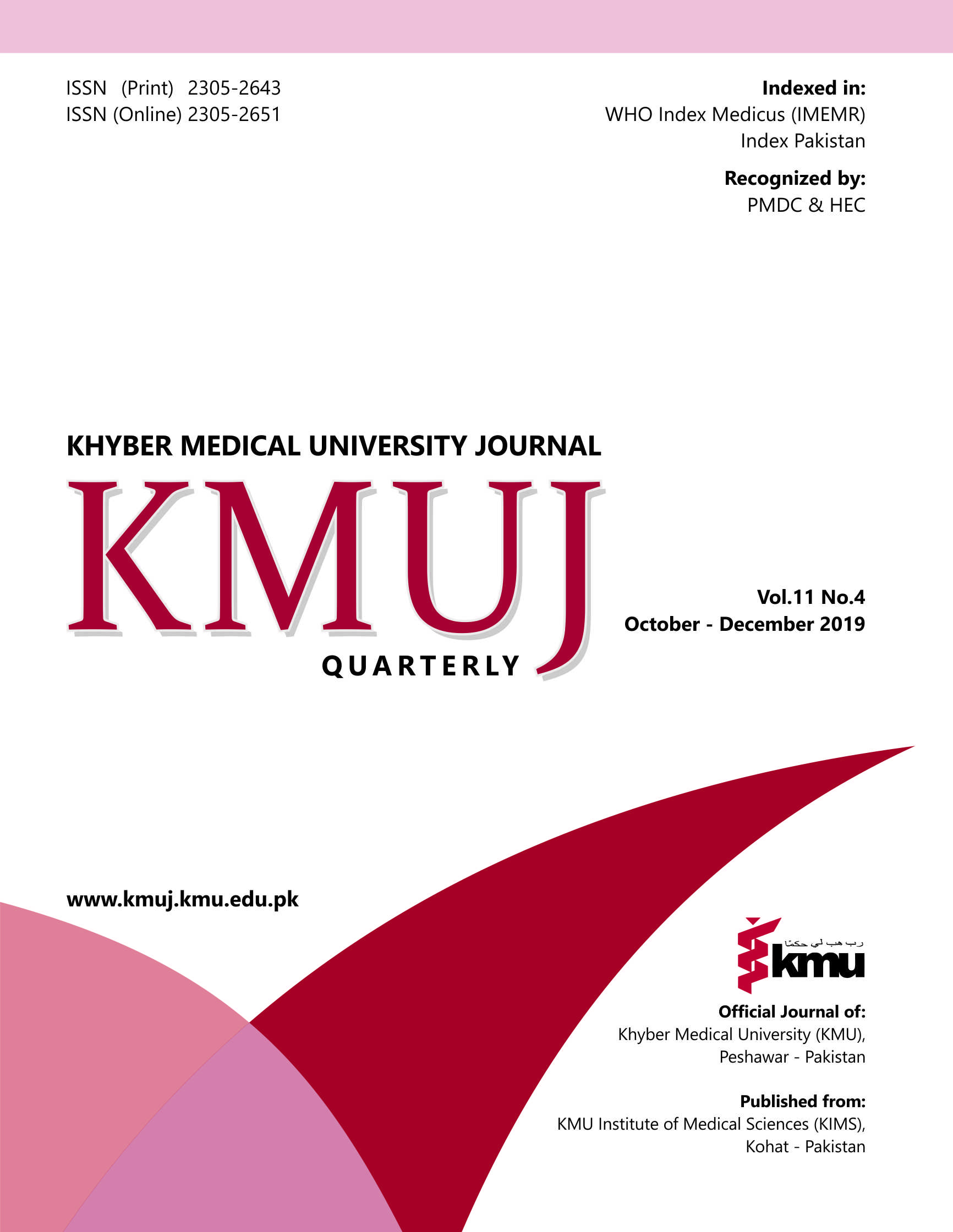DIAGNOSTIC ACCURACY OF SPOT URINE PROTEIN TO CREATININE RATIO FOR ESTIMATION OF SIGNIFICANT PROTEINURIA IN PATIENTS OF PREECLAMPSIA
Main Article Content
Abstract
OBJECTIVE: To determine diagnostic accuracy of spot urine protein to creatinine ratio (PCR) for estimation of significant proteinuria in patients of preeclampsia based on 24-hour urine protein.
METHODS: This cross-sectional validation study was conducted at Gynae B unit, Lady Reading Hospital, Peshawar from July 2014 to December 2014. Out of 253 patients, 222 women were finally enrolled as per inclusion and exclusion criteria by using non-probability convenient sampling technique. After taking proper history and calculating period of gestation, blood pressure was measured using standard sphygmomanometer while urinary protein by urine dipsticks. Following standard protocol, urine was collected for 24 hours followed by spot midstream urine. Samples were analyzed for urine protein and creatinine. 24 hours urinary protein level ≥300 mg/day and Spot urine PCR was ≥3 mg/mmol was considered significant proteinuria. SPSS v 16.0 was used a statistical instrument.
RESULTS: Out of 222 patients with preeclampsia, 24-hours urinary protein level estimation was ≥300 mg/day in 179 (80.6%) cases and <300 mg/day in 43 (19.4%) cases. Spot urine PCR was ≥3 mg/mmol in 175 (78.8%) cases and <3 mg/mmol in 47 (21.2%) cases. The sensitivity, specificity, positive predictive value (PPV), negative predictive value (NPV) and diagnostic accuracy of spot urine PCR against 24-hours urinary protein level estimation was 95.5%, 90.6%, 97.7% 82.9% and 94.5% respectively.
CONCLUSION: In our study, spot urinary protein/ creatinine ratio shows a high sensitivity, specificity, PPV, and NPV (at a cut off value >0.3 mg/mmol). This test can be regarded as a reliable investigation among pre-eclamptic patients.
Article Details
Work published in KMUJ is licensed under a
Creative Commons Attribution 4.0 License
Authors are permitted and encouraged to post their work online (e.g., in institutional repositories or on their website) prior to and during the submission process, as it can lead to productive exchanges, as well as earlier and greater citation of published work.
(e.g., in institutional repositories or on their website) prior to and during the submission process, as it can lead to productive exchanges, as well as earlier and greater citation of published work.
References
Shaikh SA, Shaikh S Shaikh GS. Optimal diagnostic value of random urine protein to creatinine ratio over 24 hour urine excretion in women with preeclampsia at Chandka Medical College Hospital Larkana. Med Channel 2010;16(3)413-16.
Sultan N. Pregnancy in Pakistan. The forgotten millennium development goal? A Global Village 2011;(3):51-3. Available from URL: https://aglobalvillage.org/journal/issue3/in_the_field/pregnancy-in-pakistan/
Huang Q, Gao Y, Yu Y, Wang W, Wang S, Zhong M. Urinary Spot Albumin: Creatinine Ratio for Documenting Proteinuria in Women With Preeclampsia. Rev Obstet Gynecol 2012;5(1):9-15.
Rizk D, Agarwal MM, Pathan JY, Obineche EN. Predicting proteinuria in hypertensive pregnancies with urinary protein-creatinine or calcium-creatinine ratio. J Perinatol 2007;27(5):272–7.DOI: 10.1038/sj.jp.7211689.
Park JH, Chung D, Cho HY, Kim YH, Son GH, Park YW, et al. Random urine protein/creatinine ratio readily predicts proteinuria in preeclampsia. Obstet Gynecol Sci 2013;56(1):8-14.
Eslamian L, Behnam F, Tehrani ZF, Jamal A, Maroosi V. Random Urine Protein Creatinine Ratio as a Pre admission Test in Hypertensive Pregnancies with Urinary Protein Creatinine Ratio. Acta Med Iran 2011;49(2):81-4.
Sheikh F, Venyo A. Proteinuria in Pregnancy: A Review of the Literature. Webmd Central Obstet Gynaecol 2012;3(11): WMC003814. DOI: 10.9754/journal.wmc.2012.003814.
Waugh JJS, Smith MC. Hypertensive disorders. In: Edmonds K. Dewhurst textbook of obstetrics and gynaecology. 8th Edition: Wiley-Blackwell;2012.p.101-9.
Price CP, Newall RG, Boyd JC. Use of Protein: Creatinine Ratio Measurements on Random Urine Samples for Prediction of Significant Proteinuria: A Systematic Review. Clin Chem 2005;51(9):1577-86. DOI: 10.1373/clinchem.2005.049742.
Aggarwal N, Suri V, Soni S, Chopra V, Kohli HS. A prospective comparison of spot urine protein-Creatinine ratio versus 24-hour urinary protein excretion in women with preeclampsia. Medscape J Med 2002;10(4):98.
Cade TJ, Gilbert SA, Polyakov A, Hotchin A. The accuracy of spot urinary protein-to-creatinine ratio in confirming proteinuria in pre-eclampsia. Aust N Z J Obstet Gynaecol 2012;52(2):179-82. DOI: 10.1111/j.1479-828X.2011.01409.x.
Dwyer BK, Gorman M, Carroll IR, Druzin M. Urinalysis vs. urine protein–creatinine ratio to predict significant proteinuria in pregnancy. J Perinatol 2008;28(7):461-7. DOI: 10.1038/jp.2008.4.
Roudsari FV, Ayati S, Ayatollahi H, Shakeri MT. Protein/creatinine ratio on random urine samples for prediction of proteinuria in preeclampsia. Hypertens Pregnancy. 2012;31(2):240-42.DOI: 10.3109/10641955.2010.507838.
Shahbazian N, Hosseini AF: A comparison of spot urine protein- creatinine ratio with 24 hour urine protein excretion in women with pre-clampsia. Iranian J Kidney dis. 2008;2(3):127-31.
Leanos-Miranda A, Marquez-Acosta J, Romero-Arauz F, Cardenas-Mondragon GM, Rivera-Leanos R, Isordia-Salas I, et al. Protein:creatinine ratio in random urine samples is a reliable marker of increased 24-hour protein excretion in hospitalized women with hypertensive disorders of pregnancy. Clin Chem. 2007;53(9):1623–28. DOI: 10.1373/clinchem.2007.089334.
Durnwald C, Mercer B. A prospective comparison of total protein/creatinine ratio versus 24-hour urine protein in women with suspected preeclampsia. Am J Obstet Gynecol 2003;189(3):848-52. DOI: 10.1067/s0002-9378(03)00849-4.
Sharma A, Kiran P, Ajaj B. Spot urine protein/creatinine ratio—A quick and accurate method for diagnosis of preeclampsia. Open J Gynaecol Obstet 2013;3(8):609-12
